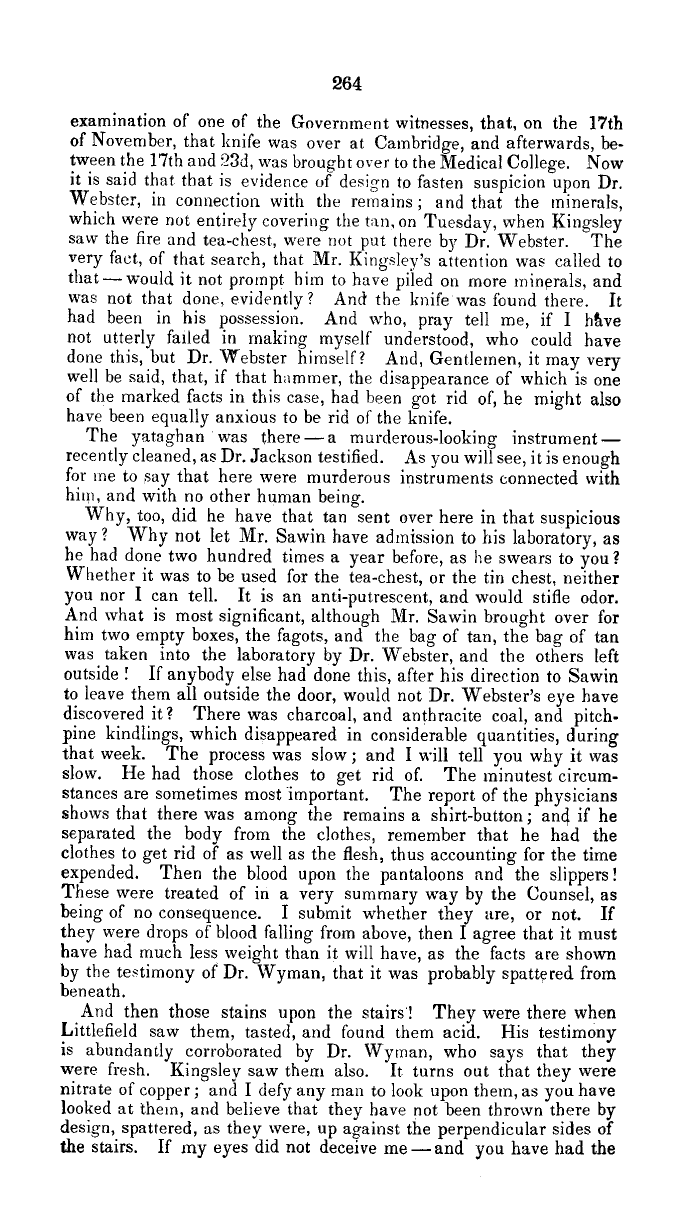|
264
examination of one of the Government witnesses, that, on the 17th
of November, that knife was over at Cambridge, and afterwards, be-
tween the 17th and 23d, was brought over to the Medical College. Now
it is said that that is evidence of design to fasten suspicion upon Dr.
Webster, in connection with the remains ; and that the minerals,
which were not entirely covering the tan, on Tuesday, when Kingsley
saw the fire and tea-chest, were not put there by Dr. Webster. The
very fact, of that search, that Mr. Kingslev's attention was called to
that-would it not prompt. him to have piled on more minerals, and
was not that done, evidently? And the knife was found there. It
had been in his possession. And who, pray tell me, if I hhve
not utterly failed in making myself understood, who could have
done this, but Dr. Webster himself? And, Gentlemen, it may very
well be said, that, if that hammer, the disappearance of which is one
of the marked facts in this case, had been got rid of, he might also
have been equally anxious to be rid of the knife.
The yataghan was there-a murderous-looking instrument-
recently cleaned, as Dr. Jackson testified. As you will see, it is enough
for me to say that here were murderous instruments connected with
him, and with no other human being.
Why, too, did he have that tan sent over here in that suspicious
way? Why not let Mr. Sawin have admission to his laboratory, as
he had done two hundred times a year before, as he swears to you?
Whether it was to be used for the tea-chest, or the tin chest, neither
you nor I can tell. It is an anti-putrescent, and would stifle odor.
And what is most significant, although Mr. Sawin brought over for
him two empty boxes, the fagots and the bag of tan, the bag of tan
was taken into the laboratory by Dr. Webster, and the others left
outside ! If anybody else had done this, after his direction to Sawin
to leave them all outside the door, would not Dr. Webster's eye have
discovered it? There was charcoal, and anthracite coal, and pitch-
pine kindlings, which disappeared in considerable quantities, during
that week. The process was slow; and I will tell you why it was
slow. He had those clothes to get rid of. The minutest circum-
stances are sometimes most important. The report of the physicians
shows that there was among the remains a shirt-button; and if he
separated the body from the clothes, remember that he had the
clothes to get rid of as well as the flesh, thus accounting for the time
expended. Then the blood upon the pantaloons and the slippers!
These were treated of in a very summary way by the Counsel, as
being of no consequence. I submit whether they are, or not. If
they were drops of blood falling from above, then I agree that it must
have had much less weight than it will have, as the facts are shown
by the testimony of Dr. Wyman, that it was probably spattered from
beneath.
And then those stains upon the stairs! They were there when
Littlefield saw them, tasted, and found them acid. His testimony
is abundantly corroborated by Dr. Wyman, who says that they
were fresh. Kingsley saw them also. It turns out that they were
nitrate of copper; arid I defy any man to look upon them, as you have
looked at them, and believe that they have not been thrown there by
design, spattered, as they were, up against the perpendicular sides of
the stairs. If my eyes did not deceive me-and you have had the
|

